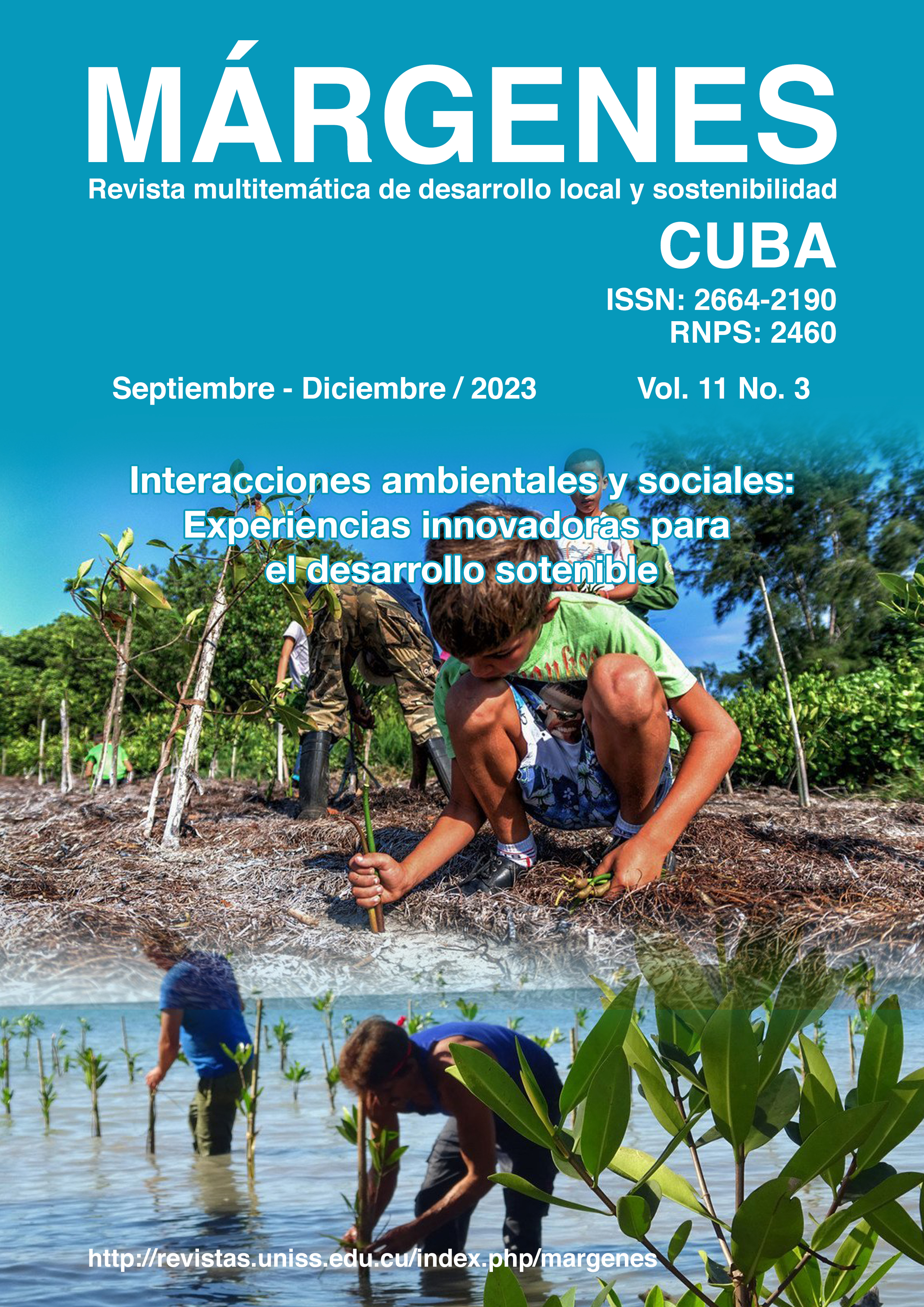IMPACTO AMBIENTAL DE ALTERNATIVAS ENERGÉTICAS SOBRE EL PROCESO DE SECADO DE ARROZ UTILIZANDO BIOMASA / ENVIRONMENTAL IMPACT OF ENERGY ALTERNATIVES ON THE RICE DRYING PROCESS USING BIOMASS
Resumen
Introducción: La producción de arroz en Cuba es altamente dependiente del consumo de diesel y energía eléctrica. Es además alta generadora de residuos con potencial energético.
Objetivo: El presente trabajo tiene como objetivo evaluar el impacto ambiental de varias alternativas energéticas sobre el proceso de secado del arroz en la UEB “Tamarindo” perteneciente a la Empresa Agroindustrial de Granos Sur del Jíbaro del municipio La Sierpe, Sancti Spíritus, utilizando residuos de las producciones arroceras y porcinas disponibles en la unidad.
Métodos: Se utilizó la metodología Análisis de Ciclo de Vida mediante el método de evaluación de impacto ambiental ReCiPe con categorías de daños en punto final y en punto medio, donde se realizó un análisis más detallado sobre 18 categorías de impacto en estudios de caracterización y normalización. Se llevó a cabo un análisis de sensibilidad valorando variaciones en la variable de más incertidumbre.
Resultados: Los resultados mostraron una disminución significativa del impacto ambiental con la sustitución completa del diésel de secado y la energía eléctrica de la red nacional por la energía generada a partir de la cascarilla de arroz. Los impactos perjudiciales más notables se encontraron en ecotoxicidad marina, ecotoxicidad del agua dulce, consumo de agua y toxicidad humana carcinogénica.
Conclusiones: Para todos los casos el flujo de mayor impacto fue el del arroz en su etapa agrícola, se evidenció además que las alternativas propuestas tienen significativo impacto
beneficioso sobre el consumo de recursos, calentamiento global, ecotoxicidad terrestre y consumo de agua.
Palabras clave: análisis de ciclo de vida; evaluación de impactos ambientales; producción de arroz
ABSTRACTIntroduction: Rice production in Cuba is highly dependent on diesel and electric energy consumption. It also generates high amounts of waste with energy potential.
Objective: The objective of this paper is to assess the environmental impact of several energy alternatives on the rice drying process in the UEB "Tamarindo" belonging to the Agroindustrial Grain Enterprise Sur del Jíbaro in La Sierpe, Sancti Spíritus, using available waste from rice and swine production.
Methods: The Life Cycle Assessment methodology was used through the ReCiPe environmental impact assessment method with endpoint and midpoint damage categories, where a more detailed analysis was carried out on 18 impact categories in characterization and normalization studies. A sensitivity analysis was carried out assessing variations in the most uncertain variable.
Results: The results showed a significant decrease in environmental impact with the complete substitution of drying diesel and electrical energy from the national grid by energy generated from rice husk. The major detrimental impacts were found in marine ecotoxicity, freshwater ecotoxicity, water consumption and carcinogenic human toxicity.
Conclusions: For all cases the flow with the highest impact was that of rice in its agricultural stage. It was also evidenced that the proposed alternatives have significant beneficial impact on resource consumption, global warming, terrestrial ecotoxicity and water consumption.
Keywords: environmental impact assessment; life cycle assessment; rice production
Descargas
Citas
Dahlgren, S. (2022). Biogas-based fuels as renewable energy in the transport sector: an overview of the potential of using CBG, LBG and other vehicle fuels produced from biogas. Biofuels, 13(5), 587-599. https://www.tandfonline.com/doi/epdf/10.1080/17597269.2020.1821571?needAccess=true&role=button
Gadde, B., Christoph, M. & Reiner, W. (2009). Rice straw as a renewable energy source in India, Thailand, and the Philippines: Overall potential and limitations for energy contribution and greenhouse gas mitigation. Biomass and bioenergy, 33(11), 1532-1546. https://www.sciencedirect.com/getaccess/pii/S0961953409001585/purchase
Gahlot, P., Balasundaram, G., Tyagi, V. K., Atabani, A. E., Suthar, S., Kazmi, A. A., Štěpanec, L, Juchelková, D. y Kumar, A. (2022). Principles and potential of thermal hydrolysis of sewage sludge to enhance anaerobic digestion. Environmental Research, 113856. https://ui.adsabs.harvard.edu/link_gateway/2022ER....214k3856G/PUB_HTML
Goedkopp, M., Heijungs, R., Huijbregts, M., Schryver, A. D., Struijs, J. & Zelm, R. V. (2008). ReCiPe. A life cycle impact assessment method which comprises harmonized category indicators at the midpoint and the endpoint level. https://dvikan.no/ntnu-studentserver/reports/selected%20sections%20-%20Goedkoop%20etal%20ReCiPe_main_report_final_27-02-2009_web.pdf
López Acosta, J. C. (2019). Aprovechamiento de la cascarilla de arroz para la cogeneración eléctrica [Trabajo de Especialidad, Asistencia de Investigación, Universidad de Ibagué] https://repositorio.unibague.edu.co/server/api/core/bitstreams/2156f7b0-c8fe-4cb5-89c2-6e74461437b2/content
Méndez Vives, M. C. (2010). Características de la cascarilla de arroz para utilizar como energía renovable en gasificación. [Trabajo de grado, Universidad de los Andes] https://repositorio.uniandes.edu.co/bitstream/handle/1992/24547/u419491.pdf?sequence=1
Pereda Reyes, I., Pagés Díaz, J. y Sárvári Horváth, Ll. (2015). Anaerobic Biodegradation of Solid Substrates from Agroindustrial Activities-Slaughterhouse Wastes and Agrowastes. https://www.intechopen.com/chapters/48997
Popović, A. & Radivojević, V. (2022). The circular economy - Principles, strategies and goals. Economics of Sustainable Development, 6(1), 45-56. https://scindeks-clanci.ceon.rs/data/pdf/2560-421X/2022/2560-421X2201045P.pdf
Samal, P., Babu, S. C., Mondal, B. & Mishra, S. N. (2022). The global rice agriculture towards 2050: An inter-continental perspective. Outlook on Agriculture, 51. https://krishi.icar.gov.in/jspui/handle/123456789/76861
Suki, N. M., Suki, N. M., Sharif, A., Afshan, S. & Jermsittiparsert, K. (2022). The role of technology innovation and renewable energy in reducing environmental degradation in Malaysia: A step towards sustainable environment. Renewable Energy, 182, 245-253. https://ideas.repec.org/a/eee/renene/v182y2022icp245-253.html
Unión de Nacionalización Española [UNE] (2006). ISO 14040. Gestión Ambiental. Análisis de Ciclo de Vida. Principios y marco de Referencia. https://www.une.org/encuentra-tu-norma/busca-tu-norma/norma?c=N0038060
Publicado
Versiones
- 16-12-2024 (7)
- 29-11-2023 (6)
Cómo citar
Número
Sección
Licencia
Derechos de autor 2023 Ernesto Jesús Pomares Fiallo, Sively Domínguez Gómez, Yasmani Alba Reyes, Félix Orestes Hermida García, Ernesto Luis Barrera Cardoso

Esta obra está bajo una licencia internacional Creative Commons Atribución-NoComercial-SinDerivadas 4.0.



_(Custom).jpg)



















